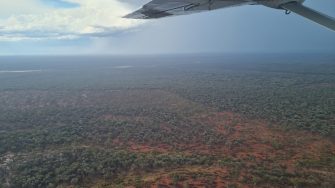
Date: Sunday, November 8, 2020
Project: Eastern Australian Waterbird Survey
Observers: Richard Kingsford UNSW, John Porter UNSW/DPIE
Pilot: James Barkell NSW National Parks & Wildlife Service (DPIE)
The early morning was clear and still – perfect for flying and the cooler temperatures persisted during the morning. After leaving Windorah we flew past the flat terrain with the occasional creek, all tributaries to the Diamantina River.
There were predominantly dry wetlands across these areas, except for a few dams drawing on artesian bore water.
We then arrived at the Diamantina River floodplain; it’s the first of several major arid river floodplain we surveyed – the others were the Georgina and Mulligan river systems. We flew down the complex braided channels of the Diamantina where only the deepest waterholes and billabongs still held water after rainfall earlier in the year - there were relatively few waterbirds, mainly pelicans, wood duck and egrets.
A little bit further west we came to the Eyre Creek floodplain, part of the Georgina River catchment where Lake Machattie had water; it’s a large (>18,000ha) wetland, and today it was about 50% full and very shallow as it was drying back. But it was still spectacular, supporting thousands of waterbirds including, pink-eared duck, black duck, grey teal, pelicans and spoonbills, terns, avocets and migratory waders. A little further to the west, Lake Mipia was also about half full, with not as many waterbirds but a high diversity.
A little further west we surveyed the saline wetlands that fill from the Mulligan River - Lakes Torquinnie and Mumbleberry. They sometimes support tens of thousands of waterbirds – but today they were dry.
From here we turned south and refuelled at Birdsville before continuing on to survey band 7.
Our first wetland on survey band 7 was the Diamantina River waterholes which are permanently full but rarely support many waterbirds; as expected there were only a few pelicans and cormorants.
The rest of the floodplain wetlands, including Goyders Lagoon, weredry but one large claypan Lake Uloowarranie, still held residual water though it was drying rapidly. It was shallow and had few waterbirds – mainly pink-eared duck, grey teal, wood duck, spoonbills and stilts.
As we headed west, there were signs of recent rains with green tinged areas scattered across the landscape.
Further west we passed south of the dry Lake Yamma Yamma before surveying the waterholes along Cooper Creek. The floodplain was dry but there were a few waterbirds, including black duck and pelicans mostly on the waterholes.
As we flew further eastwards the landscape became progressively drier and there were few natural wetlands holding water. There was a large summer thunderstorm which created a few difficulties with navigation and visibility as we approached our final stop for the day, Charleville.
Blog by John Porter
